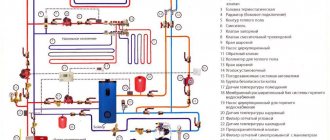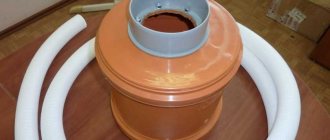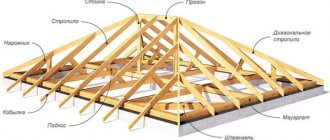Frame construction has a number of undeniable advantages over conventional houses. It allows you to quickly build, does not require special professional skills, and is characterized by the simplicity of the design of houses. In addition, heat saving indicators are high.
In this article we will talk about how to arrange the heating of a frame house, what requirements are imposed on the heating system and which one should be preferred. It must be said that frame houses allow you to organize heating of any type in them - from a traditional Russian stove to convectors.
Heating system for a frame house
There are numerous options for organizing heating in a frame house, which occurs due to the good heat conservation of such types of buildings. Any coolant can be used. The choice of heating system depends on the personal preferences of the home owners and the budget allocated for this matter.
A frame house can be heated:
- Using gas (natural, liquefied), diesel fuel;
- Solid fuel;
- Electricity;
- Systems that receive energy from the earth or the sun.
The best option is to install a combined type frame house heating system. This approach will allow you to heat your home regardless of environmental conditions.
Combined heating may include an electric boiler, a solid fuel fireplace, air heating of a frame house and solar panels on the roof. At night, the house will be heated with water in an electric boiler and in a heated floor system, which will allow the use of a night tariff to calculate electrical energy; in the evening, you can use a solid fuel boiler, and when there is no precipitation, solar panels. In addition, some of the system elements are replaceable with analogues. For example, radiators can be used instead of heated floors, and a gas boiler can replace an electric one.
Fashionable system - warm baseboard
Among modern heating systems for frame houses, warm baseboards can also be distinguished. It is a type of water heating. The point here is that radiators are laid along all the walls. They are only 20 cm high. The tubes and radiator elements themselves are hidden under a decorative protective profile. Such miniature size and excellent aesthetic appearance will add special sophistication to any room.
Its heat exchanger is made of copper-aluminum materials, so it has very good heat transfer. It is not subject to corrosion and is not afraid of high pressure. The heat from such a baseboard is evenly distributed throughout the room, due to which there are no cold zones. Therefore, it is very comfortable to be in such a room.
- Author: Mikhail Malofeev
Rate this article:
- 5
- 4
- 3
- 2
- 1
(1 vote, average: 5 out of 5)
Share with your friends!
Heating system installation procedure
Before starting work on installing a heating system, you need to decide on its type. Afterwards, you need to draw up a project for placing its elements throughout the house, purchase the necessary equipment and materials for installation.
Thanks to the frame structure, laying heating pipes can be carried out at the very end of construction work. But if you don’t want to disassemble the wall cladding, then you should think about the heating system in advance.
As a rule, heating pipes are mounted on top of the frame and finishing; placement between the wall and sheets of drywall is often found. The external option is preferable, since it will not be necessary to perform any actions with the structure of the house, and access to communications will also be provided in case of their breakdown.
If you plan to install a combination boiler, you will need to strengthen the foundation under its location in advance, since the unit has considerable weight. In addition, it is necessary to consider a fire extinguishing system in case of an emergency. In this regard, a combination boiler is a rather problematic option.
Features of frames
Before considering options, it is necessary to identify the main features associated specifically with this type of structure. What is a frame? This is a house made using the so-called Canadian technology. Its popularity in the CIS is due to several factors:
- Similar climatic conditions in Canada with Russia, Belarus and neighboring countries
- Low cost of construction, which is more economical than traditional construction methods
- High speed. So, for example, good companies can build such a home within a month
- Quite a good set of walls and ceilings that retain heat indoors
- Manufacturability coupled with durability. The estimated lifespan of such buildings can reach 100 years.
- Possibility of free planning, allowing owners to choose the number of rooms and their size at the design stage
It is the last factor that does not allow us to give any exact recipes for heating. After all, different areas require different approaches to heating the air. But the basic method remains the same. Let's move on to them.
Electrical heating
Heating for a frame house using electricity is a fairly popular option, but the cost of constantly heating the building with its help is relatively high. Its installation does not require obtaining any special permits, it can be carried out in any conditions, and there is no need to spend money on consumables.
The electric boiler is installed according to the rules for installing any other electrical equipment. Wiring is calculated based on the power of the equipment with a reserve for overloads and requires reliable insulation.
Convectors
A convector is a metal body of a certain design with an inlet and outlet to create the effect of air convection. There is a heating element inside the convector. Heating elements come in several types (in order of technical evolution): needle-shaped with filaments, heating elements, X-shaped monoliths, and monoliths with “scales” - Hedgehog. The inlet channel is closed with various types of filters to protect against dust, the outlet - with a decorative grille to protect against the ingress of small objects and more uniform distribution of heated air.
The convector body not only serves as protection for the heating element, but also increases the speed of the upward flow. Due to this, with the same power, the room is heated faster than from a water heating battery.
The stylish convector panel looks great in a modern interior Source teplo-vsem.ru
Convectors have three types of thermostats - mechanical, electronic and, more recently, inverter.
A mechanical and electronic thermostat is a thermal relay that turns the convector on and off depending on the temperature set on it. In a mechanical thermostat, the temperature is set by a manual regulator, often “by eye”; in an electronic thermostat, by touch buttons with a digital indication of the temperature value.
The inverter thermostat (control unit), unlike the mechanical and electronic thermostat, which operate in on/off mode, controls the operation of the convector according to a different principle - with automatic change of heating power, which allows achieving high energy efficiency indicators. Such savings can reach 40-70% of electricity compared to the usual on/off convector.
The reason for this saving is in such a thing as hysteresis: this is the temperature difference at which the thermostat turns the device on and off. Convectors with a mechanical or electronic thermostat turn on and off not when the set temperature is reached exactly, but with an error predetermined by the manufacturer. This is done so that the heater does not turn on and off at a high frequency (the lower the hysteresis, the higher this frequency). In this case, the automation would quickly fail. Therefore, such convectors always have a difference of several degrees between turning on and off, no matter how accurately they measure the temperature. And these extra degrees on/off of convectors consume extra electricity.
A convector with an inverter thermostat operates according to a different algorithm: it does not have parameters such as the temperature at which the heater turns on and off. The inverter thermostat does not turn off/turn on the heating, but automatically reduces/increases the heating power depending on the temperature difference and the rate of change of this temperature.
Warm floor
The underfloor heating system is installed on subfloors. It is first necessary to install a vapor barrier on the surface to protect the floor from moisture. Next, heat-reflecting material is laid to prevent heat dissipation, after which heating mats are laid. Finally, finishing and installation of heated floor control systems are carried out.
The advantage of the solution is that warm air rises up from the surface of the floors and is distributed throughout the entire space of the room, and cold air falls to the bottom, where it also warms up.
An important condition for using electric heating
Most importantly, to use electric heating without spending too much money, it is important that your home is very well insulated! This is extremely important! That is why the inhabitants of the right frame houses use ordinary electric convectors and chuckle when looking at the inhabitants of brick and block cottages sighing about the exorbitantly high heating bills!
When is it more profitable to use electric convectors, and when is it more profitable to use an electric boiler with radiators or heated floors?
Some customers ask us which electric heating option to choose, electric convectors for each window or an electric boiler with radiators?
Our answer is:
If you are building a garden or country house in which you live only from spring to autumn, then the choice is obvious - electric convectors! They are indifferent to sub-zero temperatures, they will cost less, and their installation can be done by anyone without a degree in electrical engineering. In case of failure, the convector is simply replaced with a new one. Their cost is almost the same as that of heating radiators, and they do not require pipes, pumps, or a boiler.
The disadvantage of electric convectors is that inexpensive models dry the air, not everyone likes this.
If your home is intended for permanent residence, and you prefer heated floors, then the choice is definitely an electric boiler with water heated floors.
In other cases - according to your taste.
Electric boiler
You can install an electric boiler yourself, but a number of nuances should be taken into account:
- The cross-section of the wires must comply with the requirements specified in the documents for the equipment;
- The switch may only be placed in the same room as the boiler;
- If you plan to use a boiler, then it should be located above the electric boiler;
- Wiring in a frame house must be done in advance;
- Installation of electrical equipment requires strict adherence to safety precautions in order to avoid electric shock;
- The boiler must be regularly inspected for leaks and damage to the insulation.
Latest generation systems
Many people have heard about “warm baseboard” or “contour” class systems. Such heating, in fact, is built according to the classical scheme of heating and coolant circulation, but differs in slightly different standards, namely:
- the amount of coolant in the system is small;
- the circulation rate is high and occurs forcibly with the help of pumps, whereas classical systems can use natural convection circulation.
- As a result, contour systems have the following advantages:
- can be installed by hand without significant amounts of construction work;
- often do not require the creation of technical areas where heating equipment will be located.
However, heating with contour systems also has disadvantages:
- the initial period of warming up the house lasts a very long time;
- when the heater is turned off, the system temperature drops quickly;
- electricity consumption is necessarily higher, since even circuits using gas heaters use circulation pumps.
It is possible to build a “warm baseboard” or “circuit” system using only electric heaters, but the cost of using such a solution is very high.
Gas heating
Heating a frame house with gas is the most popular method. A gas boiler has long served as a reliable source of heat in the house.
It should be noted that gas supply to the house is not so fast and not so simple. You will first need to obtain permits from various authorities over the course of several months.
Gas heating can be installed only with the help of special equipment, which is not cheap. Installation and commissioning work is just as expensive, which is why many people prefer electric heating systems.
However, if we consider the long term, gas heating will be much cheaper than other types of heating. The low price of gas covers the cost of installing equipment. In just a few years, you will “recoup” all the money spent.
What type of fuel can be called the most accessible and cheapest?
A dispute often arises as to which fuel is the cheapest in the absence of mains gas. We are looking for the cheapest heating without gas based on the experience of our forum users.
ArtashirFORUMHOUSE user
I decided to make an approximate calculation of the costs of operating different types of heating equipment over a period of 15 years, including the cost of energy, for the following heating systems:
- gas (gas boiler);
- heating with wood;
- heating using wood pellets;
- electric (electric boiler).
The forum member used the following as initial data:
- Residential building area - 100 sq.m;
- The duration of the heating period is 8 months;
- The average power of equipment during the heating period (efficiency) is 50%;
- Specific power of the climatic zone is 1.5 kW (Khanty-Mansiysk Autonomous Okrug - Yugra).
Hot water supply and gas stove are not taken into account in the calculations.
And this is what happened.
As can be seen from the tables presented, the most expensive heating is electricity at a daily rate. The cheapest is main gas, solid fuel is in the middle of this rating. It is also necessary to familiarize yourself with the results of a similar calculation by a user of our site under the nickname bkostik.
BkostikFORUMHOUSE user
I made calculations in relation to St. Petersburg.
As can be seen from the table, heating with diesel fuel and bottled gas is one of the most expensive, but heating with electricity, when using the night tariff, is not so expensive. However, this does not mean that everyone can install an electric boiler for themselves, because... Not in all settlements the required power can be allocated to a house. In order for heating a house without gas, with electricity alone, to be truly profitable, a number of conditions must be met. Namely:
The house must be well insulated;
- Heat loss through building envelopes (walls, floors, roofs) as well as windows and doors should be minimized;
- A heat accumulator is required.
Stove heating and fireplaces
Heating a frame house without using gas can be done using a stove or fireplace. Since time immemorial, people have loved to look at fire, which gives a feeling of coziness and comfort. Modern solutions offer many ways to contemplate “live” fire. Their use makes it possible to create a feeling of comfort in the house, and the fireplace itself can act as a heater.
Among the advantages of a fireplace are high heat accumulation and its uniform distribution. The materials for making fireplaces are presented in a wide range, so everyone will find something to suit their taste. Of course, fireplaces are not without their drawbacks. The most tangible is the need to purchase firewood to keep the fire going. In addition, when using it, it is very important to follow fire safety rules.
An alternative option is stove heating of a frame house. If you constantly add firewood as needed, the stove will maintain the required level of heat in the house for a long period of time. In addition, the premises will be heated already five minus after kindling. There are also very different options for the implementation of stoves; the unit can be placed in a corner, near a wall and in other places. In addition, the oven can be used for cooking food.
Selection of radiators - what are they?
Probably, many remember that recent period when cast iron radiators were installed in all apartments and houses. For a more presentable appearance, it was necessary to paint the radiator unit once every 1–2 years. But, despite this main drawback, today they have the leading ability to withstand high pressure. They can also boast a long service life.
If the main thing when choosing is price, then you can pay attention to steel radiators. They look quite attractive. In terms of performance, they have good heat transfer and convection. Due to their price and positive characteristics, they have become widespread. But their main disadvantage is their susceptibility to corrosion.
Using a solid fuel boiler
Heating for a frame house using a solid fuel boiler is the best option for houses without gas supply. It allows you to use a wide variety of raw materials for heating - firewood, peat briquettes, wood and paper production waste. In a solid fuel boiler, not only the raw materials themselves are burned, but also the gas released during the process, which can significantly increase the efficiency of the equipment.
The principle of operation of a solid fuel boiler is as follows: through the heat exchanger pipes in the boiler, the air mass is heated, which subsequently enters the premises of the building. The convection process makes it possible to increase the temperature in the house to the required values within a short time.
Equipment operating on solid fuel supports several operating algorithms:
- Stage-by-stage heating of the house;
- Fast heating;
- Maintains the set temperature for 12-15 hours.
Video description
In our video we’ll talk about heating in a private country house. Our guest is the author and presenter of the Teplo-Voda channel Vladimir Sukhorukov:
Oil radiator
Considered uneconomical - critics argue that it should not be used as a heating device due to high energy consumption and low output. But it is this type of device that has one of the highest efficiency - about 98%. That is, it converts almost all electrical energy into heat (the law of conservation of energy has not yet been canceled), and those minor losses of 2% are due to the resistance of the internal walls of the radiator to the coolant. Yes, it is inertial - it takes a long time to warm up, but it also takes a long time to cool down.
On a note! Accordingly, when using an oil radiator, the room in which it is used will warm up for a long time.
But this is a property of all batteries, including water heating, in which the main method of heat transfer is radiation, which works slowly.
The main disadvantage is the “rough” power control and the use of mechanical thermostats. And such inaccurate control of temperature conditions makes an oil radiator ineffective when trying to optimize the cost of heating with electricity in a private home. And yet, it has a rather high body temperature when operating at full power, which is dangerous if there are small children in the house.
In defense of oil radiators, let’s say that these are still devices for temporary local heating and high energy efficiency has never been required of them.
There are models of oil radiators that can be hung on the wall Source b-sector.ru
Fan heater
It is often written about a fan heater that it burns oxygen. But “oxygen combustion” is nothing more than an oxidation (combustion) process, and the maximum that can burn at a fairly low temperature of the coil is organic dust in the air. Therefore, it is incorrect to talk about burning oxygen (after all, it’s not wood that burns) since this insignificant volume must be replenished as a result of mandatory ventilation of the room.
The efficiency of such a device is slightly lower than that of an oil radiator (part of the electricity is spent on operating the fan), but it is not very different, considering that the power of the fan motor itself is small (about 50 W out of a total of 1 or 2 kW). The advantage is that the room warms up very quickly. Disadvantages are a constant noise level (albeit insignificant) and dust transfer throughout the room. And the main drawback of these household appliances is manual power adjustment and the illusory possibility of creating an automated heating system based on fan heaters
A fan heater is the most compact heating device, and it is great for heating a small area Source romb.ua
Therefore, it is necessary to emphasize once again that the main reason why some types of electric heaters are not suitable for heating a home is not the efficiency (almost all of them are above 95%), but the impossibility of automating system control. It is this factor that does not allow optimizing the operation of the heating system, and without this it is impossible to heat a house with electricity cheaply.
Nuances and conclusions
To ensure maximum effect from the heating system, the frame house must be properly insulated. At the same time, not only floors and walls require thermal insulation. According to research, the greatest heat loss occurs through ceilings. To avoid this, you need to insulate not only the ceiling, but also the attic space, if there is one in your house.
This concludes our review of the most popular options for heating a frame house. Any solution has its own list of pros and cons. When choosing a heating system, you should take into account the area of the building, whether it is possible to supply gas and other nuances. However, the most rational option would be to use a combined type of heating.
— Why not install cheaper wall convectors?
It would seem - indeed, because convectors do not require installation of a boiler, pipe routing, and so on. One-time costs are lower. At the same time, their energy consumption is similar to that of a system with an electric boiler. But we shouldn’t discount the following fact: if we install an electric boiler, the cable is connected to the boiler - and we get one potentially dangerous point. If we are talking about convectors, then the number of such connection points is equal to the number of convectors. That is, their operation requires very competent electrical wiring. All cables must be twisted very tightly, the cable must be copper, the twists must be insulated, and all this must be in fireproof casings.
Liquid fuel
This is probably the last option that should be considered when solving the problem of how to heat a house if there is no gas. It's not even about the price of energy resources - they can be different. The most expensive diesel fuel allows you to obtain thermal energy at the same cost as using liquefied gas from cylinders. The price of heat when burning fuel oil is the same as that of coal-fired boilers, and “working off” practically compares heating costs to the level of natural gas. But…
In terms of equipment cost, this is one of the most expensive fuel-using systems. In addition, these boilers are “capricious”, requiring regular maintenance and the same complexity of maintenance as the fuel supply and injection systems of a diesel car. There are also disadvantages such as air pollution from liquid fuel combustion products, as well as high noise levels from the operation of the fuel pump and burner.
Maintenance of an oil-fuel boiler is much more difficult than any other Source enemcon.com











